amsmeteor.org, 8/4/13, Robert Lumsford

Radiant positions at 4am LDT
Meteor activity kicks into high gear in August as seen from the northern hemisphere. The main reason for all this activity is the Perseid shower that peaks on August 12. This shower is active most of the month and remains above the level of the sporadic background for a week centered on August 12. The sporadic activity is also near maximum as seen from the northern hemisphere and is now more than double the rates from just three months ago. As seen from south of the equator, meteor rates are still decent but falling rapidly. The sporadic rates continue their downward slide and the Perseid radiant does not rise high into the sky as seen in the southern hemisphere so rates from this shower are greatly reduced when compared to the northern hemisphere.
During this period the moon reaches its new phase on Tuesday August 6th. At this time the moon is located near the the sun and will be invisible at night. This weekend the waning crescent moon will not interfere with observing as it is very thin and will only rise just before the start of morning twilight. Toward the end of this period the waxing crescent moon will enter the evening sky but again it will be very thin and will set soon after dusk. The estimated total hourly meteor rates for evening observers this week is near five for observers located in the northern hemisphere and three for those viewing south of the equator. For morning observers the estimated total hourly rates should be near thirty-five as seen from mid-northern latitudes and near thirty for observers viewing from tropical southern latitudes. The actual rates will also depend on factors such as personal light and motion perception, local weather conditions, alertness and experience in watching meteor activity. Note that the hourly rates listed below are estimates as viewed from dark sky sites away from urban light sources. Observers viewing from urban areas will see less activity as only the brightest meteors will be visible from such locations.

